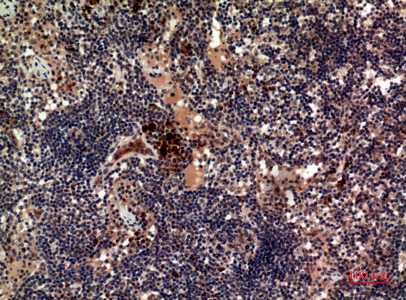产品名称
RANKL Rabbit Polyclonal Antibody
别名
TNFSF11; OPGL; RANKL; TRANCE; Tumor necrosis factor ligand superfamily member 11; Osteoclast differentiation factor; ODF; Osteoprotegerin ligand; OPGLReceptor activator of nuclear factor kappa-B ligand; RANKL; TNF-related activation-induced cytokine; TRANCE; CD254
蛋白名称
Tumor necrosis factor ligand superfamily member 11
存储缓冲液
Liquid in PBS containing 50% glycerol, 0.5% BSA and 0.02% New type preservative N.
Human Gene Link
http://www.ncbi.nlm.nih.gov/sites/entrez?db=gene&term=8600
Human Swissprot No.
O14788
Human Swissprot Link
http://www.uniprot.org/uniprotkb/O14788/entry
Mouse Gene Link
http://www.ncbi.nlm.nih.gov/sites/entrez?db=gene&term=21943
Mouse Swissprot No.
O35235
Mouse Swissprot Link
http://www.uniprot.org/uniprot/O35235
Rat Gene Link
http://www.ncbi.nlm.nih.gov/sites/entrez?db=gene&term=117516
Rat Swissprot Link
http://www.uniprot.org/uniprot/Q9ESE2
免疫原
The antiserum was produced against synthesized peptide derived from the C-terminal region of human TNFSF11. AA range:268-317
特异性
RANKL Polyclonal Antibody detects endogenous levels of RANKL protein.
稀释度
WB 1:500 - 1:2000. IHC-p: 1:100-300 ELISA: 1:20000. IF 1:100-300 Not yet tested in other applications.
宿主
Polyclonal, Rabbit,IgG
背景介绍
This gene encodes a member of the tumor necrosis factor (TNF) cytokine family which is a ligand for osteoprotegerin and functions as a key factor for osteoclast differentiation and activation. This protein was shown to be a dentritic cell survival factor and is involved in the regulation of T cell-dependent immune response. T cell activation was reported to induce expression of this gene and lead to an increase of osteoclastogenesis and bone loss. This protein was shown to activate antiapoptotic kinase AKT/PKB through a signaling complex involving SRC kinase and tumor necrosis factor receptor-associated factor (TRAF) 6, which indicated this protein may have a role in the regulation of cell apoptosis. Targeted disruption of the related gene in mice led to severe osteopetrosis and a lack of osteoclasts. The deficient mice exhibited defects in early differentiation of T and B ly
组织表达
Highest in the peripheral lymph nodes, weak in spleen, peripheral blood Leukocytes, bone marrow, heart, placenta, skeletal muscle, stomach and thyroid.
细胞定位
[Isoform 1]: Cell membrane; Single-pass type II membrane protein.; [Isoform 3]: Cell membrane; Single-pass type II membrane protein.; [Isoform 2]: Cytoplasm .; [Tumor necrosis factor ligand superfamily member 11, soluble form]: Secreted .
信号通路
Cytokine-cytokine receptor interaction;
功能
disease:Defects in TNFSF11 are the cause of osteopetrosis autosomal recessive type 2 (OPTB2) [MIM:259710]; also known as osteoclast-poor osteopetrosis. Osteopetrosis is a rare genetic disease characterized by abnormally dense bone, due to defective resorption of immature bone. The disorder occurs in two forms: a severe autosomal recessive form occurring in utero, infancy, or childhood, and a benign autosomal dominant form occurring in adolescence or adulthood. Autosomal recessive osteopetrosis is usually associated with normal or elevated amount of non-functional osteoclasts. OPTB2 is characterized by paucity of osteoclasts, suggesting a molecular defect in osteoclast development.,function:Cytokine that binds to TNFRSF11B/OPG and to TNFRSF11A/RANK. Osteoclast differentiation and activation factor. Augments the ability of dendritic cells to stimulate naive T-cell proliferation. May be an important regulator of interactions between T-cells and dendritic cells and may play a role in the regulation of the T-cell-dependent immune response. May also play an important role in enhanced bone-resorption in humoral hypercalcemia of malignancy.,induction:Up-regulated by T-cell receptor stimulation.,PTM:The soluble form of isoform 1 derives from the membrane form by proteolytic processing (By similarity). The cleavage may be catalyzed by ADAM17.,similarity:Belongs to the tumor necrosis factor family.,subunit:Homotrimer.,tissue specificity:Highest in the peripheral lymph nodes, weak in spleen, peripheral blood Leukocytes, bone marrow, heart, placenta, skeletal muscle, stomach and thyroid.,
纯化
The antibody was affinity-purified from rabbit antiserum by affinity-chromatography using epitope-specific immunogen.

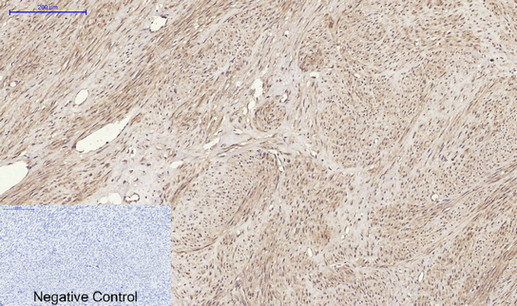
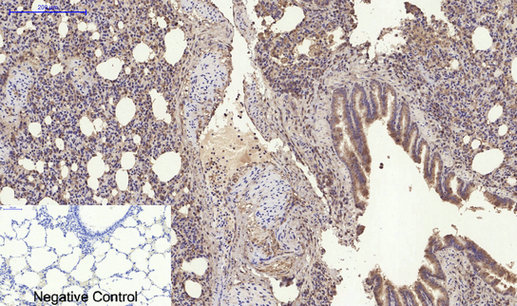
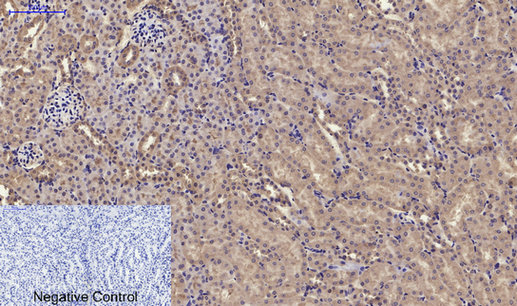
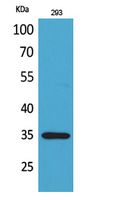
.jpg)
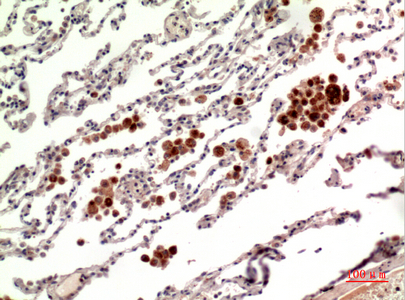
.jpg)
